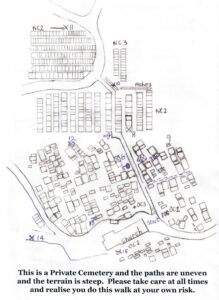
Map adapted by Valerie Crouch and Ivan Burrowes
CEMETERY WALK STOPS:
1. Leave the church and walk up the steps and immediately on your right you will find the headstone for JOHN GIBBS. He laid down the original part of the Cemetery in grass and finished it in 1866. Read the inscription.
1. Leave the church and walk up the steps and immediately on your right you will find the headstone for JOHN GIBBS. He laid down the original part of the Cemetery in grass and finished it in 1866. Read the inscription.
2. Then move up a little further and take a right turn, at a gap in the rail. You will find, on your left, a modern memorial headstone for William John Robson. He served on St John’s Vestry for 35 years from 1859 – 1894. When he immigrated there were lots of seeds and cuttings amongst their effects and he is recorded as having grown an amazing wisteria. His work on the Bible Garden was famous.
3. Before you return to the main concrete path look for the headstone of Dr Gray Brewster, alias Dr Thomas Oldham. Marion says “his obvious competency made him a welcome immigrant”. Herein lies an unsolved mystery.
4. Returning to the main path and up hill on your right you will see the headstone of Robert Boddington. His wife died first and there is a newer addition to the headstone announcing his death. He was a founder and supporter of St Johns.
5. Turn your eyes to the other side of the path now and you will see a specimen of what Marion called a Glastonbury Thorn—-actually Colletia paradoxa. This tree actually comes for Uruguay and is known as the anchor plant or jet plane plant. Marion tells an interesting story about its survival in the church-yard.
6. Next door is the headstone of a well known couple, who need no introduction to locals—Mary Ann and Edward Baigent. They are often referred to as the founders of Wakefield, after coming from England aboard the CLIFFORD in 1842. Notice they died 6 days apart. The headstone faces in from the path but on the back of it (facing the path), is a little plaque erected at a Baigent reunion.
7. Continue to the giant Redwoods and underneath a great branch you will find another reunion plaque for the Clark Family 1992. This family travelled with the Baigents from England and remained firm friends.
8. You are now entering a more “ordered”, newer part of the Cemetery and just on your right look for the headstone of Ernest Hodgson. This one is actually in Row 11 of New Cemetery #1. He was Sunday School Superintendent for 34 continuous years.
9. Turn around clockwise and look back in the Old Cemetery and you might spot, under a huge totara, the poignant child’s grave of Our Little Teddy, the origins of which are lost.
10. Back on the path and after leaving this older part of the Cemetery, you will come to new ashes berms and here you will find the resting place of Marion and Buster Stringer. Marion was a teacher at Wakefield school and was the author of several well known local books.
11. Climb right to the top of the hill enjoying the vista from the “Lawn Cemetery”, New Cemetery # 2, and there you can have a rest on Ray and Kathleen Williams’ Seat. Ray was vicar from 1977 until 1983 and his family had this seat dedicated when they scattered their parents ashes at Labour weekend 2016.
12. Now head down the road and through the ordered rows of NC #1, dodging branches of the Sequoia Dendron giganteum. From here the headstones are harder to find, but at this stop you will find head stones of the Henry Faulkner whanau. You will recognise the name from Faulkner’s Bush. He lived in a large house south of the church on land called Treeton Park. He was a Synodsman, Church Warden
and Vestryman for many years.
and Vestryman for many years.
13. Have the Vestry in your sights, over the grass, (there grassy paths), towards the Church to find Rev Thomas Adolphus Bowden’s commanding headstone. He was the first vicar of St John’s to be buried in the cemetery. He was the vicar of Wakefield from 1856 – 1858. Canon Bernard Machell is also there now in NC #2.
14. Somehow you need to go back up, taking in a multitude of older headstones, and find an easier way to get off the grass and back onto the back road towards the List A protected Redwoods or Sequoia sempervirens, the Coastal Redwoods.
15. Then finally head back towards the main road side of the church and onto the grass to find the headstone of Commander Wilson. Some of the oldest graves are here and many no longer have headstones.
Many of these cemetery notes are from Marion Stringer’s: 150th Anniversary History

Comments (0)